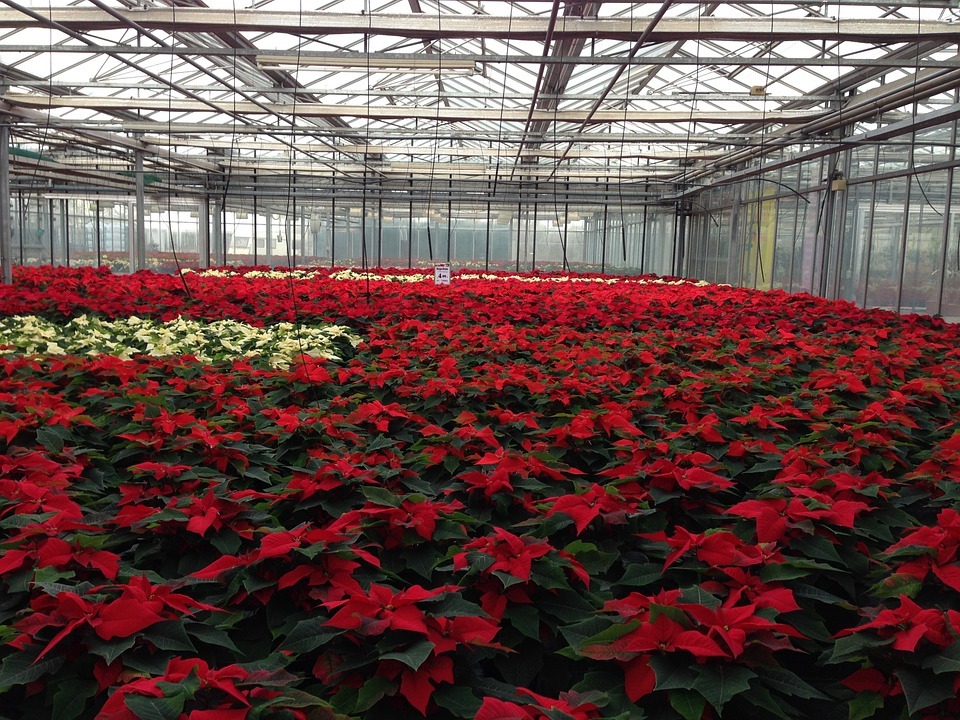Our “Cabinet Curiosities” series explores significant items in our Herbarium collection. Posts are contributed by staff, volunteers, and interns.
The poinsettia is a quintessential part of typical holiday decor. Its bright red, burgundy, or white foliage are common sights in locations both private and public throughout the winter months, from apartment balconies and church altars to bank lobbies and coffeehouses. And as you can see in the specimen image below, not even time can wipe away the bright colors on the bracts, still distinguishable after 22 years in a cabinet. But do you know the history of poinsettias, the namesake of this most festive member of the Spurge Family?

Before they were known as poinsettias, Euphorbia pulcherrima was known as cuitlaxochitlIto the Aztecs, who used the plant as a source for dyes and fever-reducing medicine. Following the arrival of Spanish influence in Mexico and Guatemala, the red blooms became associated with Christmas, and the plant was given the new name “Flor de Noche Buena” or Christmas Eve Flower. One 16th century Christian legend tells a story about a young girl, too poor to provide a gift for Jesus, who was inspired by an angel to pick weeds and form a bouquet. After placing the bouquet on her church’s altar, the weeds became crimson blossoms and turned into poinsettias.

But how did poinsettias arrive in the United States, and how did they gain their most recognizable name? For a long time after European colonization, poinsettias were not well known outside of Mexico until the work of one man in the 19th century. Joel Roberts Poinsett was the first U.S. envoy to the recently established Mexican Republic in 1825. Until his recall 5 years later, J.R. Poinsett worked to further U.S. interests in Mexico and counter actions by Great Britain as a supporter of the Monroe Doctrine. But Poinsett was also an amateur botanist, like many of his contemporaries, and became enamored with a common shrub called “Flor de Nochebuena” growing in a suburb near Mexico City. He sent samples to his greenhouse in South Carolina and widely distributed cuttings to friends, and by 1836, E. pulcherrima was known by the common name Poinsettia.

It’s also notable that Poinsett was a leading figure of the National Institute for the Promotion of Science, which collected and stored artifacts from United States Exploring Expeditions, in addition to patent models, natural objects, and historical items of American statesmen. This organization was one of many that jockeyed for control of the wealthy Smithsonian bequest to the United States government in 1838, but struggled to find continued funding and ultimately became part of the Smithsonian collection.
Despite the association of poinsettias with Christmas in Mexico, a similar association in the U.S. was not firmly established until the mid-20th century with the help of the Ecke family in California. The story begins with Albert Ecke, a German immigrant who moved to Los Angeles in 1900 and sold poinsettia cuttings from a street stand as a side business. His son, Paul Ecke, developed a special grafting technique that created potted poinsettias with a more attractive bushy appearance. But the third-generation owner, Paul Ecke Jr., was the individual truly responsible for the nationwide acceptance of poinsettias as a holiday decoration. With the help of his family’s secret growing techniques, Paul Ecke, Jr. widely advertised poinsettias by shipping cuttings by air and providing free decorations for national television shows and holiday specials. For many decades the Ecke family held a monopoly over poinsettias, like DeBeers to diamonds, the secret known only to a handful of family members and the head horticulturalist. That is, until 1991 when a university researcher discovered the exact technique to graft two different varieties of E. pulcherrima to recreate the Ecke Family poinsettia. Following the revelation, rival growers began to steal market share thanks to cheap labor in South America; but as of 2008, Ecke Farms still provides 70% of the domestic and 50% of the global poinsettia market. Though they stopped harvesting plants for general sale at their flagship farm, the Ecke family is still involved with developing novelty breeds but at hair-thin margins in a cut-throat market. Lastly, in 2002 a congressional action named December 12th as National Poinsettia Day in honor of Joel Poinsett’s death in 1851 to recognize his contributions to science and American politics.

The poinsettia is an interesting and uniquely American creation, born of a foreign nation and brought to the US by an American but popularized by a naturalized European immigrant and his family. Something to think about as you decorate this year in preparation for National Poinsettia Day! Thanks for tuning in on another episode of Cabinet Curiosities. See you next month for another interesting article on holiday botany!
Resources:
https://www.rainforest-alliance.org/species/poinsettia
http://extension.illinois.edu/poinsettia/history.cfm
https://www.phoenixflowershops.com/pages/poinsettiahistory.htm






